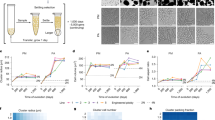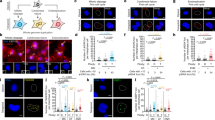Abstract
As a direct consequence of sex, organisms undergo a haploid and a diploid stage during their life cycle. Although the relative duration of haploid and diploid phases varies greatly among taxa, the diploid phase is more conspicuous in all higher organisms. Therefore it is widely believed that diploidy offers more evoutionary possibilities1–3 and is thus nearly always selected for. We have now performed computer simulations to investigate one possible advantage of diploidy, that is, protection against the expression of deleterious mutations. Instead of comparing isolated haploid and diploid populations, we considered interbreeding haploids and diploids. Diploids invaded the population only when the dominance degree of a single deleterious mutation was smaller than about 1/2, and the condition allowing diploidy to invade depended on how harmful the mutation was.
This is a preview of subscription content, access via your institution
Access options
Subscribe to this journal
Receive 51 print issues and online access
$199.00 per year
only $3.90 per issue
Buy this article
- Purchase on SpringerLink
- Instant access to full article PDF
Prices may be subject to local taxes which are calculated during checkout
Similar content being viewed by others
References
Stebbins, G. L. Variation and Evolution in Plants (Columbia University Press, New York, 1950).
Maynard Smith, J. The Evolution of Sex (Cambridge University Press, Cambridge, 1978).
Bernstein, H., Byerly, H. C. & Michod, R. E. Am. Nat. 117, 537–549 (1981).
Crow, J. F. & Kimura, M. Am. Nat. 99, 439–450 (1965).
Crow, J. F. & Kimura, M. An Introduction to Population Genetics Theory (Harper & Row, New York, 1970).
Kondrashov, A. S. & Crow, J. F. Nature 351, 314–315 (1991).
Fisher, R. A. Am. Nat. 62, 115–126 (1928).
Wright, S. Am. Nat. 68, 25–53 (1934).
Charlesworth, B. Nature 278, 848–849 (1979).
Kacser, H. & Burns, J. A. Genetics 97, 639–666 (1981).
Lewis, J. & Wolpert, L. J. theor. Biol. 78, 425–438 (1979).
Paquin, C. & Adams, J. Nature 302, 495–500 (1983).
Haldane, J. B. S. Am. Nat. 71, 337–349 (1937).
Kimura, M. Jap. J. Genet. Suppl. 36, 179–190 (1961).
Author information
Authors and Affiliations
Rights and permissions
About this article
Cite this article
Perrot, V., Richerd, S. & Valéro, M. Transition from haploidy to diploidy. Nature 351, 315–317 (1991). https://doi.org/10.1038/351315a0
Received:
Accepted:
Issue Date:
DOI: https://doi.org/10.1038/351315a0



